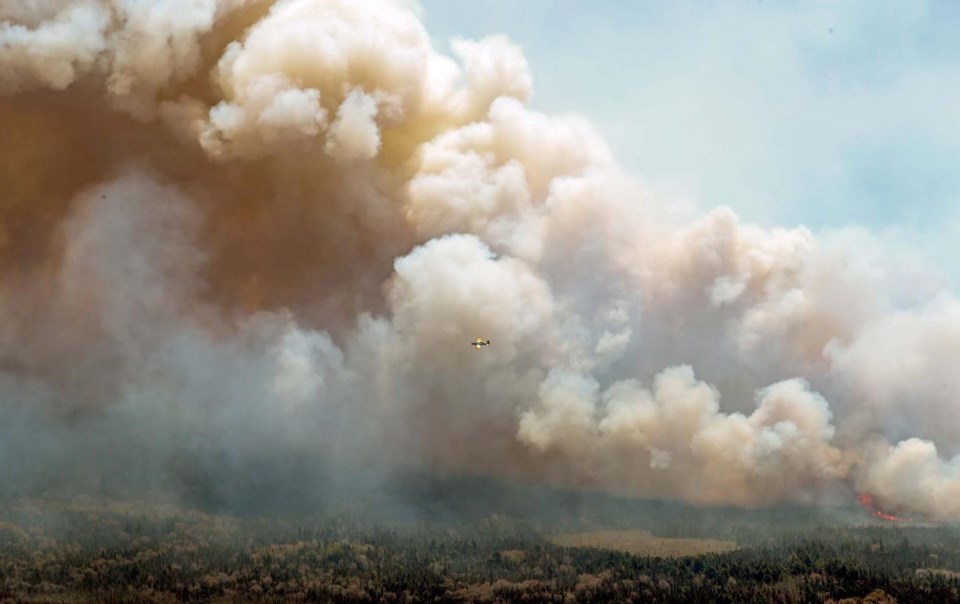HALIFAX — Climate and forestry researchers say Nova Scotia must act swiftly to prepare for future wildfires in the province's increasingly vulnerable forests.
"This new extreme weather is going be our new normal," Alana Westwood, assistant professor of environmental studies at Dalhousie University, said in a recent interview.
"So the first thing is to immediately revamp municipal and regional planning to not just consider the risk of fires, but to expect the occurrence of fires."
Andrew MacDougall, a professor at St. Francis Xavier University who contributed to the most recent United Nations Intergovernmental Panel on Climate Change — or IPCC — report, said that when wildfire records are broken — as occurred this year in southern Nova Scotia —  it's probable that global warming is a factor and that the trend will continue.
MacDougall noted a study assessing the direct role of climate change in creating extreme conditions hasn't been completed on the recent Nova Scotia wildfires, nor is he aware of one being underway.Â
However, MacDougall said it's "likely there's a climate change effect" regarding the largest wildfire in the province's history — in Shelburne County — and in the fires northwest of Halifax. Together the two fires destroyed about 210 residences and created mass evacuations.
"Even once the carbon emissions go to zero, we're stuck with the climate change that we've already created," he said. "So now that we had these bad wildfires, we just kind of have to assume that this is going to be part of our future."
The Antigonish, N.S.-based scientist said a confluence of factors is making East Coast forests more prone to burn.
First, MacDougall, a leading modeler of carbon accumulation, said the softwood forests of the East Coast have been absorbing high levels of carbon in the atmosphere, creating faster tree growth in recent decades than occurred in the last century.
Second, although greenhouse gas emissions increase moisture in the region's atmosphere, leading to more rain, the East Coast forest floor is now lined with hurricane-created debris — which can fuel fires — as coastal storms intensify.Â
Recent high temperatures — including the 32 C reached in southwestern Nova Scotia on June 1 — are combining with forest debris to create more potent burning.
Given these circumstances, MacDougall said the province should move rapidly to train more firefighters and assist municipalities to create additional exit and entrance routes from communities located near forests.
"We should not have subdivisions where there's only one exit, especially in these kind of suburban, spread-out places. That's a big concern," he said.Â
During the fires near Halifax, residents reported chaotic lineups at the sole exits from neighbourhoods after officials issued evacuation alerts.
Westwood said forestry practices in Nova Scotia must leave behind a diverse mix of tree species and tree ages. Existing practices, particularly on the predominantly privately owned woodlands, involve harvesting to the point where forests are dominated by similarly aged softwoods that are particularly vulnerable to wildfire.
The landmark 2018 Lahey Report called for a drastic reduction in clearcutting in Nova Scotia. Its recommendations included reserving the majority of the land for light-touch forestry, and dividing the rest into areas for high-production forestry and for conservation.
Westwood said that while the Nova Scotia government has brought in policy changes for Crown lands that follow this framework, the recent wildfires show that policies must also be applied to the privately owned woodlands — the bulk of the province's territory.
"Maritime forests were naturally unevenly aged … (composed of) trees of all kinds of age and size," she said.
"So, by moving to more softwood, even-aged forests, it creates the conditions that puts us at more risk."
Both scientists said the changes and preparations they're recommending must occur quickly.Â
"If we want to save pets' lives, if we want to save human lives, we need to start now," Westwood said.
"This fire season is far from over."
This report by The Canadian Press was first published June 12, 2023.
Michael Tutton, The Canadian Press



